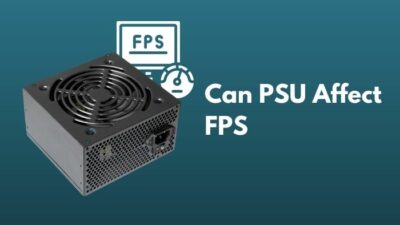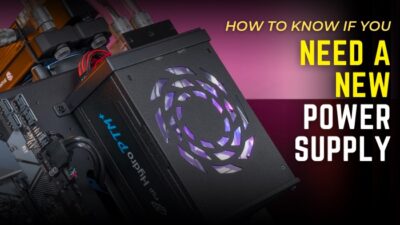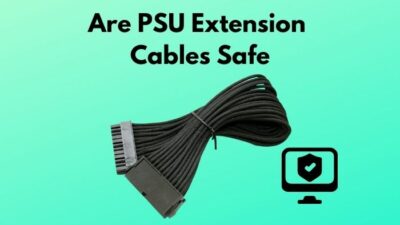If your Power Supply Unit is an old Non-modular one, and you are planning to upgrade it to a Modular one, you came to the right place.
You might be wondering:
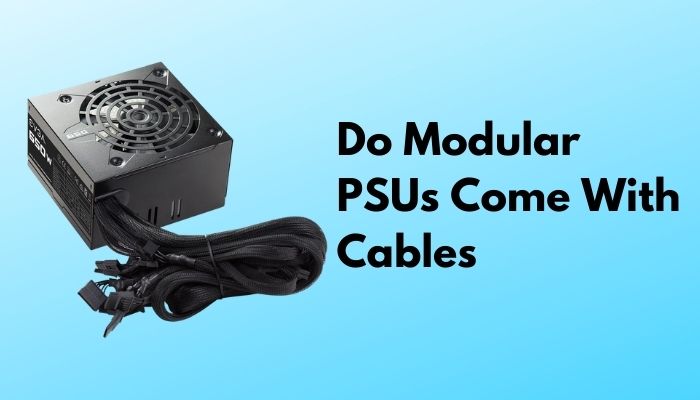
Do Modular PSUs come with cables?
As a computer nerd, I never missed out on the opportunity of building my computer, for which I had to do tonnes of research.
So, I can confidently say that you will not leave this article without getting all your questions answered.
Read this post to the end so that you can run to the store right away.
Also, check out our expert’s recommended best budget modular PSU.
Are Modular PSU cables universal?
The modular PSU cables are not universal. Modular PSU cables are detachable, so the cable pins and wattage must match the pin positions and wattage of the specific PSU brand/model. The PSU end of a PSU is proprietary and not standardized.
You may ask:
Are modular power cables standard?
Generally, Modular power cables are standard. There is nothing fancy going on about power cables, unlike those ATX/CPU/PCI-E cables. Most PSUs have the same power cable, but it’s wise to check before using it as it may sometimes vary for some brands.
The PSU manufacturers want to differentiate themselves. They are selling a product that should be able to use the cables it includes. It seems like a hassle for the manufacturers to agree on a standard cable as the production cost of these cables is very low.
A Power Supply Unit that has detachable cables is what makes it Modular. It means that you can modify the PSU by using different color-coded and braided cables and by detaching the cables you don’t need.
Do Semi-Modular PSUs come with cables?
Yes, Semi-Modular PSUs do come with all the necessary cables. They have one 24-pin ATX and CPU cables pre attached to it and all the other detachable PCI-E, SATA, Molex, and power cables.
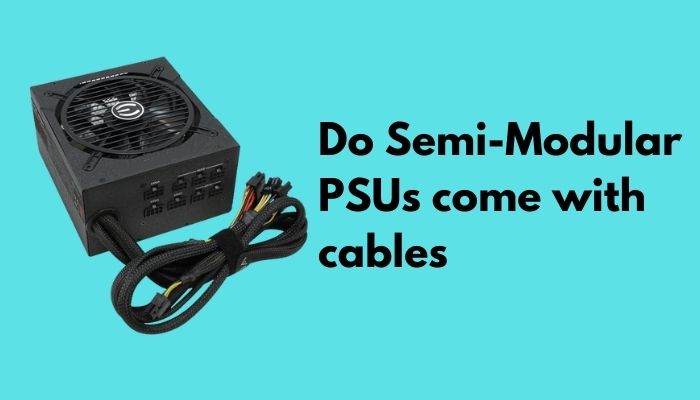
There are several types of Semi-Modular PSUs available:
- 24-pin ATX comes pre-attached, while the PCI-E, 8-pin CPU, and other cables come as modular.
- 24-pin and the PCI-E cables come pre-attached, while all the other cables come as modular.
- 24-pin and 8-pin CPU cables come pre-attached, while the PCI-E and other cables come as modular.
You might be wondering if Fully Modular PSUs are good and all as claimed. Does this mean Semi-Modular PSUs are bad? Why do they even exist? So you ask:
Is semi-modular PSU bad?
It is not bad. Semi-Modular PSU is the sweet spot as it has the best features of both: Non-Modular and Fully Modular.
If you don’t know about your PSU then check out what power supply you are using.
What cables come with a modular power supply?
Modular PSU, just like its non-modular counterpart, comes with 20/24-pin ATX, 8-pin CPU, PCI-E, SATA, and Molex cable. Semi-modular PSUs have pre attached 24-pin ATX and CPU cables, sometimes with PCI-E too.
The purpose of the 20/24-pin ATX power cable, as the name suggests, is to power your entire motherboard, including fans and lights. It is a 24-pin or 20 pins + 4 pin cable.
CPU cable is usually 4-pin or 8-pin, depending on your machine’s motherboard socket and processor’s pin requirement. Hence, this cable powers your motherboard’s socket and processor.
PCI-E/ VGA cable is used to power your graphics card and sometimes your sound card too.
SATA power cable is used to power your drives: HDD, SSD, and Optical drives.
In older PSUs/PCs, there is another type of cable called Molex cable. This cable is used to power the fans and lights of your PC. It is not needed in modern computers anymore.
Is modular power supply better?
Modular PSUs do not have any significant superiority over non-modular PSUs. Modular PSUs are better than Non-Modular PSUs in terms of cable management and aesthetics. If one of the cables gets faulty, you can replace them with the same manufacturers.
It makes the inside of your CPU pretty neat and organized with braided cables. It also makes PSU replacement easier.
This also ensures better airflow; hence, the CPU gets less hot.
You may ask:
How bad is a non-modular PSU?
Non-Modular PSU is not bad at all. It doesn’t perform any less than a Modular PSU. It just comes with all the cables permanently attached to it. Non-Modular PSUs are just getting outdated with time.
Here’s a complete guide on can PSU affect FPS.
What is the difference between semi and fully modular?
Modular PSUs allow you to attach (or detach) cables as required. In Semi-Modular PSUs, some cables are permanently attached, while other cables are detachable. Whereas, in Fully Modular PSUs, all the cables are detachable.
Two significant differences between Semi and Fully Modular PSUs are price and size. Fully Modular PSUs are higher in price and size.
You just opened your PC case, and you are wondering how to find out if your PSU is modular or not.
So you ask:
How do I know if my PSU is modular?
If all the PSU cables are detachable, then your PSU is fully modular, and if some of the cables are pre-attached while some are detachable, then your PSU is semi-modular.
Why are modular PSUs expensive?
Modular PSUs have detachable cables which offer increased airflow, easy cable management and make it aesthetically pleasing due to fewer clutters. Detachable cables require extra space in the PSUs, making them larger. These things increase the production cost.
Generally speaking, Non-Modular PSUs are the cheapest ones, whereas fully-modular ones are the most expensive, putting semi-modular PSUs in the middle.
Semi-Modular PSUs have the best of both worlds in terms of features and price. Modular PSUs are newer, and this is also a big reason why they are so expensive.
Follow our guide to know which PSU cables do I need.
Can I replace PSU cables?
You can only replace your PSU cable if you get that from the same manufacturer you bought your PSU. However, the cost of a set of cables will almost be similar, even more sometimes, to buying a brand new PSU.
You can get some custom-made cables from online customized cable stores like cablemod etc. There you can select your PSU brand, model, motherboard, and the graphics card you use to get your desired cables.
Nonetheless, this will cost you a lot of money depending on what cables you need, like ATX, PCI-E, SATA, etc. The more you need, the more expensive it is. Heck, you can just get a new PSU with that money.
Moreover, it is best to buy a new PSU rather than changing the cables since a slight mistake can burn your computer’s part. Better safe than sorry.
You may ask:
Can I reuse old PSU cables?
In general, no. You can only use cables from different PSUs if the cable and the PSU belong to the same model of the same brand, or else it will fry your computer’s components like motherboard, HDD/SSD, etc.
The pin layout or wattage on the cables varies from one PSU model/brand to another, which may lead to the death of your PC. You can only mix and match if the PSU cables belong to the same model, but it’s still a risky move.
Okay, you have made your decision, ran to the store, and bought a Modular PSU. But how do you install it?
Check out the easiest way to find out the PSU mounting screws easily.
How to install a modular power supply?
It is easier to install a Modular Power Supply Unit than a Non-modular one. There are a few steps you should follow to install your PSU correctly.
Here are the steps to install a modular power supply:
- Look for the dedicated PSU spot in your PC case. The vents at the bottom of the case will indicate where your PSU will be. You have to install your PSU above the vents.
- Ensure your PSU’s on/off switch and power cable socket is facing away from the computer. The fan of the PSU must face downwards. When your PSU lines up with the screw holes in the back panel, you will know your PSU is at the right spot.
- Screw the PSU to the dedicated spot.
- Plug the cables that your PC requires. PCs don’t usually require all the cables which come with the PSU. A 24-pin ATX cable goes to your motherboard, which is the largest slot in your PC on the right-hand side of your board.
- Count the number of pinholes in that slot to clear out your confusion. Insert the other end of the cable to your PSU as labeled or read the manual to find which is the 24-pin ATX slot. 4/8-pin CPU cable must go inside the 4/8-pin slot located at the top left-hand side of your board. This cable is often labeled as a CPU.
- Plug the PCI-E cable into your graphics card with the clip facing down. The click sound of the latch that comes with the cable will indicate that it fits correctly. Repeat the same step if you have more graphics cards.
- SATA cable goes directly to your HDD or SSD. Plug the other side of the cable to the port your PSU labeled as SATA.
- Molex cables are short with four tiny pins on the plug, but most modern computers don’t need them. You need to line these cables perfectly to the fans or other devices.
- Keep cable management in your mind while connecting your PSU to your PC components. This allows good airflow inside the CPU, thus, keeping your PC cooler.
- Ensure the wires are organized by weaving them in and out of the cable grommets, bundling them together, and securing them with a zip tie inside your PC case.
It is always wise to read the instruction manual that comes with your PSU and follow the guidelines as mentioned because the installation process may vary a bit for different PSUs or PC cases.
Final Thoughts
It is very natural for questions like these to arise before buying a new Modular PSU as Modular PSUs are relatively newer in the market. It did have a fair share of bad reputation during its early days.
This is growing, and almost all the major PSU companies make Modular PSUs more than Non-Modular, and some have stopped producing Non-Modular PSUs entirely.
The types and number of cables that come with Modular PSUs are always mentioned in the box or the company’s website you are planning to buy your PSU from. It is always best to read the details and beware of what is coming with your PSU box.

